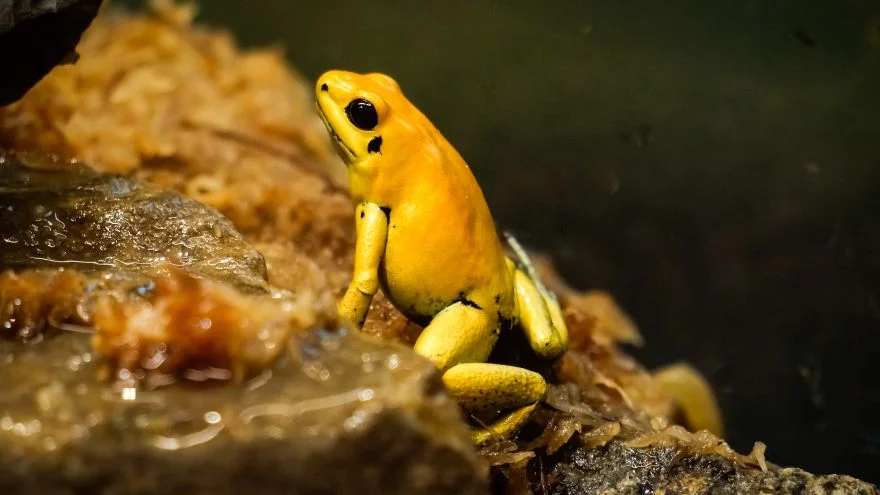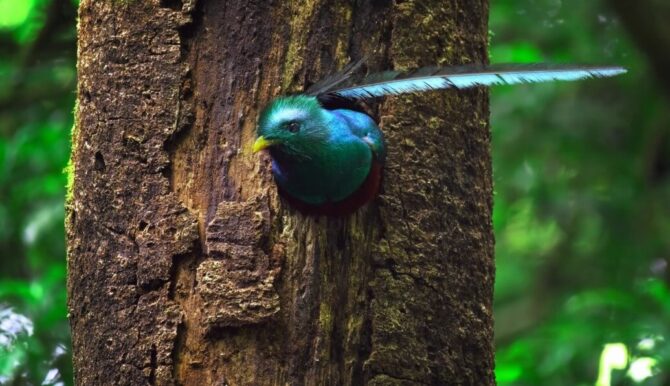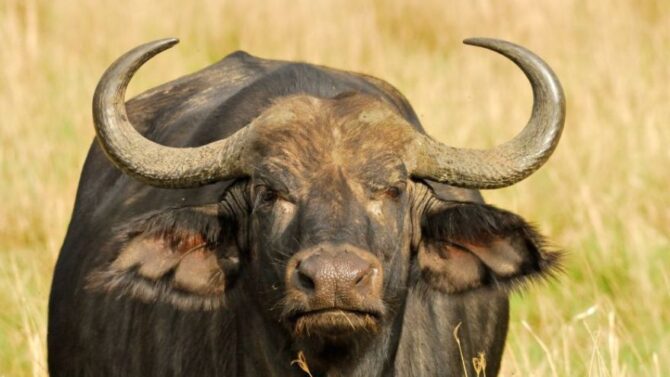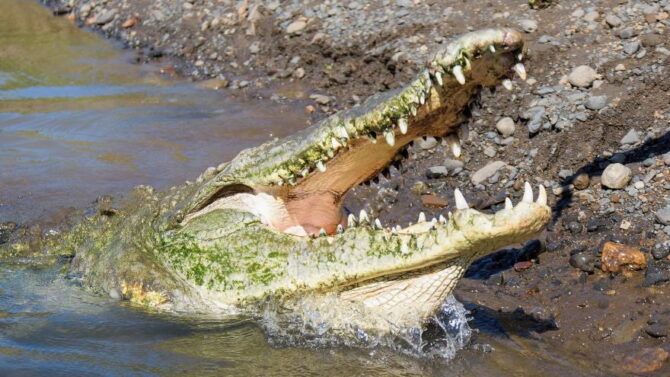Belize is a Caribbean country renowned for having incredible biodiversity and supporting various wildlife on land and water.
Its incredible jungles, striking coastlines, and lovely terrains provide an enabling ecosystem on which different types of animals thrive.
Some of these animals can be deadly when they come in contact with humans and should be avoided. The most dangerous animals in Belize include the poison dart frog, neotropical rattlesnake, eyelash viper, etc.
This article looks into 12 of the deadliest animals you should avoid in Belize, as well as safety tips for exploring wildlife in the area.
What are the Most Dangerous Animals in Belize?
1. Bullet Ant
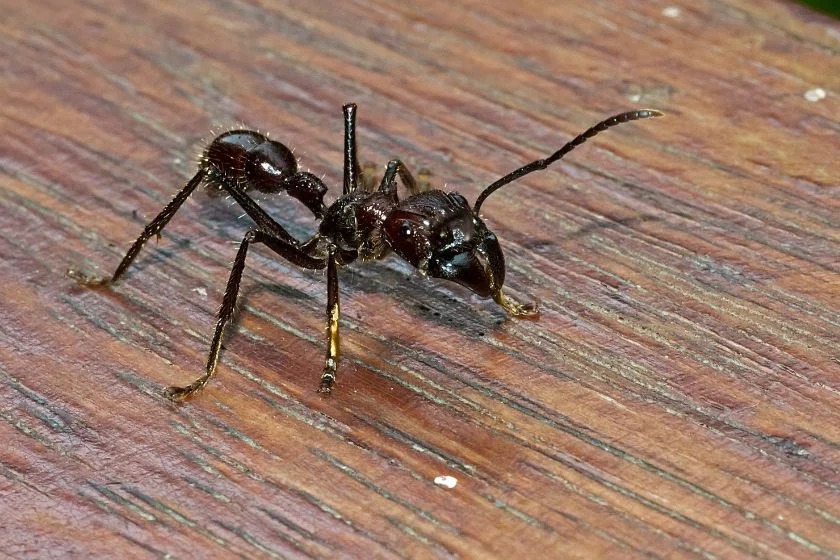
- Scientific name: Paraponera clavata
- Classification: Insect
- Habitat: Trees, shrubs, tropical forests
- Diet: Carnivore
- Conservation status: Least Concern
These ants can be found in Belize. They thrive in humid rainforests and live in many colonies, with the queen almost the same size as the workers.
While the bullet ant might seem small, the pain from its sting is mighty and excruciating. The pain has been ranks highest on the Schmidt pain index.
They are generally not aggressive except when they are defending their nest.
Common side effects from a bullet ant sting are swelling, prolonged pain, and throbbing. Be extra careful when exploring forests in Belize.
2. Poison Dart Frog

- Scientific name: Dentrobatidae
- Classification: Amphibian
- Habitat: Swamps, lakes, tropical rainforests, gardens, Rocky areas
- Diet: Carnivore
- Conservation status: Vulnerable
The poison dart frog is also called the poison arrow frog or the dart frog and is native to central and south America.
They are renowned for their bright and beautiful colors. They prey on mites, termites, and ants and commonly lay eggs on moist leaves and roots.
Do not be deceived by its bright coloration; they are extremely toxic due to the ants they eat. The brighter the coloration is, the more toxic it is.
Native Americans used their secretions to poison the tip of their blow darts hence the name poison dart frog.
The most toxic of this specie of frog is capable of killing many humans. When out in the wild in Belize, be vigilant.
3. Black Widow

- Scientific name: Latrodectus mactans
- Classification: Arachnid
- Habitat: Rock piles, rodent burrows, hollow tree stumps
- Diet: Carnivore
- Conservation status: Least Concern
The black widow is also called the shoe-button spider. They prefer temperate habitats; apart from Antarctica, they can be found worldwide.
The female black widow stings while the males don’t. The male usually becomes food for the female after mating.
The black widow, though small, is not entirely harmless.
Due to the neurotoxin contained in its venom, a sting can lead to respiratory problems, hypertension, and muscular pain.
If you suspect that you’ve been stung, seek medical help immediately. Always stay cautious when you are in one of the many forests in Belize.
4. Lionfish
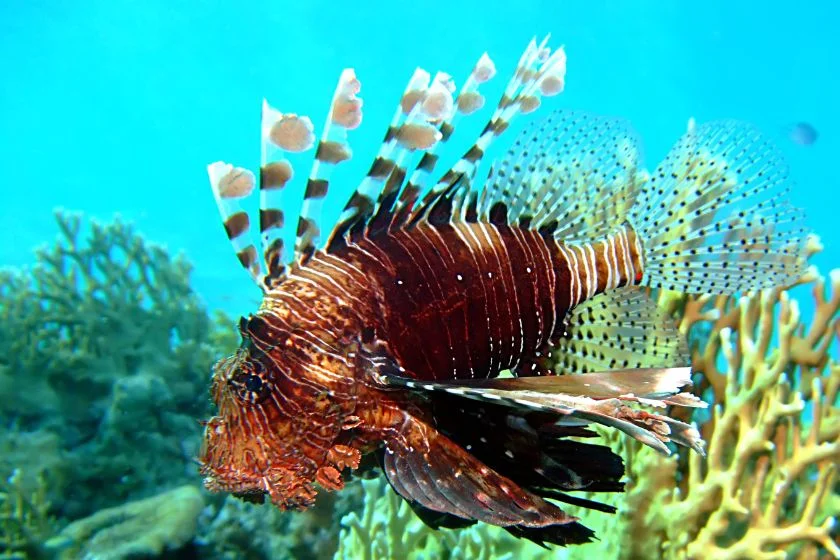
- Scientific name: Pterois
- Classification: Fish
- Habitat: Coral reefs, lagoons, harbors
- Diet: Carnivore
- Conservation status: Least Concern
The lionfish, also called the turkeyfish, the firefish, or the tastyfish, is a venomous marine fish with coloration which serves as a warning.
They are commonly used as aquarium fishes, with young lionfishes having tentacles above their eyes.
Polly Alford speared the biggest lionfish caught in Belize, and it had a length of 17.32 inches and weighed 1.7 kg.
They are dangerous because of their venomous spiky fins with potent venoms.
A young man was stung by a lionfish he had caught in the coral reefs of Turneffe Affol in Belize. He experienced intense pain and paresthesia, which spread to his forearm.
A sting can cause breathing difficulties, extreme pain, and vomiting. In rare cases, it can even cause death, especially to elderlies with weak immune systems.
Observe but don’t touch them when you sight them in Belize.
5. Mayan Coral Snake

- Scientific name: Micrurus Hippocrepis
- Classification: Reptile
- Habitat: Hardwood areas, pine, and scrub oak sandhill habitat
- Diet: Carnivore
- Conservation status: Least Concern
This species of snake, native to Belize and Guatemala, is a species of elapid snake. In appearance, they are brightly colored and small.
There is no recognized sub-specie of this snake. They are highly venomous and have the second strongest venom.
These snakes are highly dangerous. You can die from a bite.
Their venom contains neurotoxins which cause intense pain in the nervous system and shut down the heart.
Luckily, they only bite as a last resort and generally inhibit sparsely populated areas. Seek medical help immediately in case of a bite.
6. Eyelash Viper
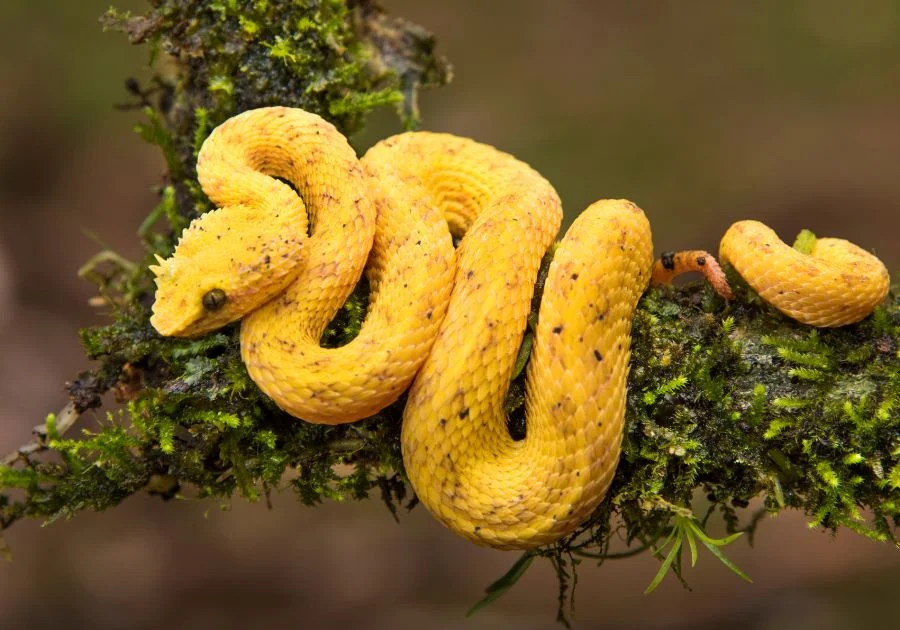
- Scientific name: Bothriechis schlegelii
- Classification: Reptile
- Habitat: Humid and tropical areas, shady ravines
- Diet: Carnivore
- Conservation status: Least Concern
This animal is a species of the pit viper family, native to central and south America. They are small in appearance, with vast color variations.
They have conspicuous scales over their eyes which give them the look of having eyelashes.
Due to having small fangs, a bite is not noticed immediately until later on.
Their venom is hemotoxic and powerful, capable of causing death within hours.
Be careful when meddling with low-lying trees and bushes, as these are the favorite spot where the eyelash viper like to lie in ambush, waiting for prey.
7. Fer de Lance
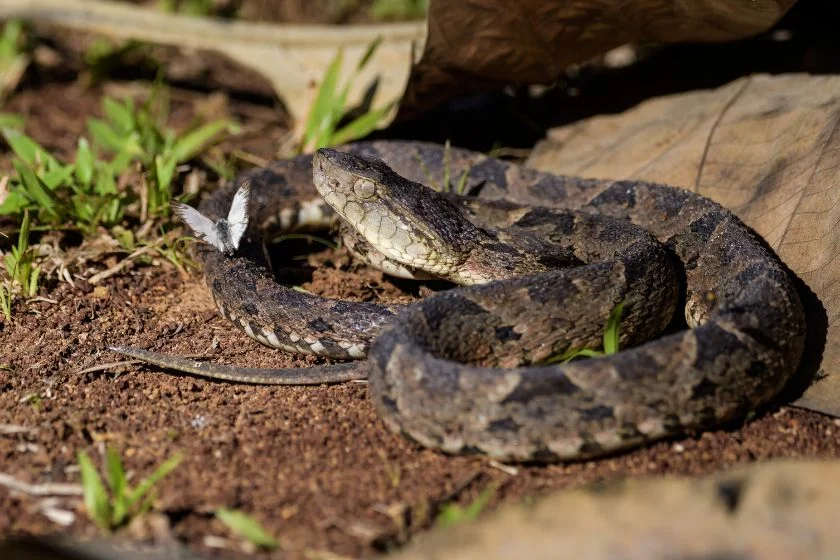
- Scientific name: Bothrops asper
- Classification: Reptile
- Habitat: Forests, rivers, streams
- Diet: Carnivores
- Conservation status: Least Concern
This snake is a species of the pit viper family, native to north, central, and south America.
With light to dark brown coloration, it has yellow zig-zagged lines on the side of its body.
Its large size and fangs are responsible for most snake bites within its range as it has an over-defensive temperament.
They strike fast and are very aggressive though they tend to avoid humans like other venomous snakes.
A bite can lead to puss and bleeding at the bite site; this causes swelling and necrosis, if not treated, might warrant the amputation of the affected limb.
Death could occur too. The fer de lance is not good news and one of the snakes you shouldn’t meddle with.
8. Hammerhead Shark
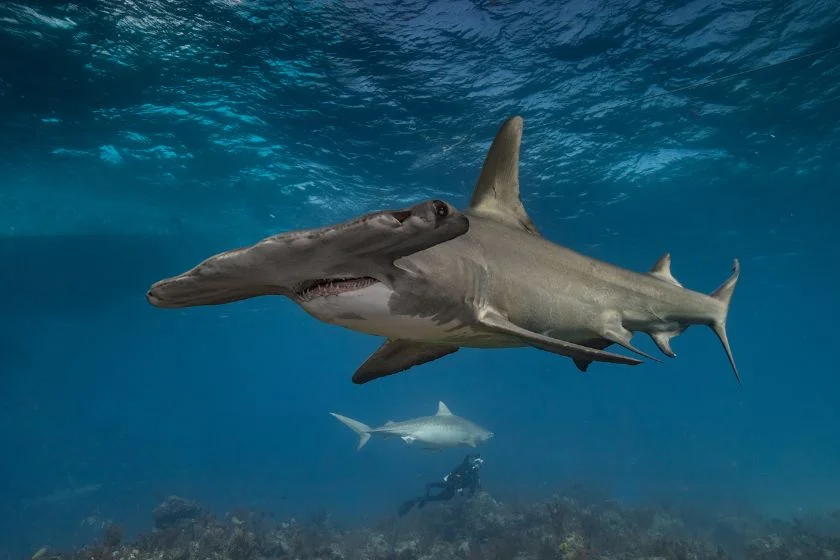
- Scientific name: Sphyrnidae
- Classification: Fish
- Habitat: Coastlines, tropical waters, deep oceans
- Diet: Carnivore
- Conservation status: Vulnerable
Renowned for their hammer-shaped head, these sharks can simultaneously zone in on prey by scent detection and view prey below and above.
They are usually found along continental shelves and coastlines.
In 2017, during the Global project finprint in Belize, scientists discovered a shark they thought was a bonnethead. After DNA analysis, the fish was an unknown hammerhead specie.
Hammerheads are capable of unprovoked attacks. With their wide jaws filled with dagger-like sharp teeth, you wouldn’t want to get bitten.
Be careful when going scuba diving in Belize. Though chances of getting bitten are low, you should be very vigilant.
9. Portuguese Man O’War
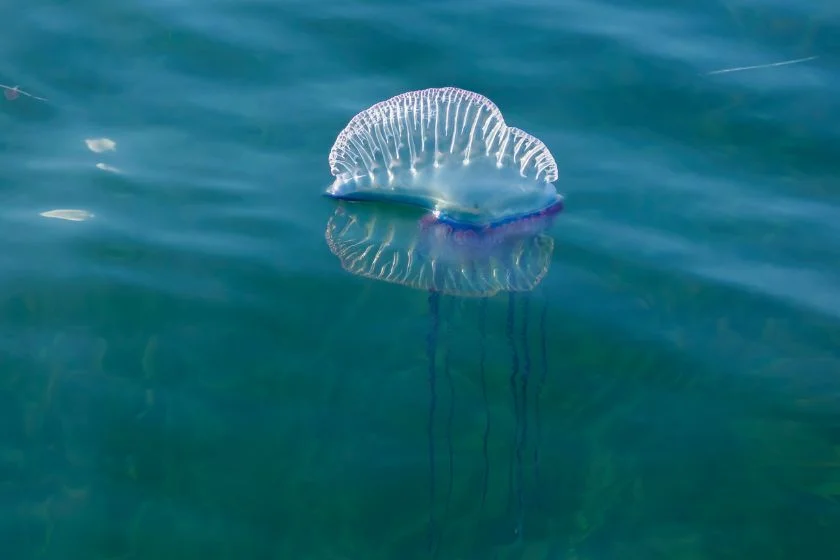
- Scientific name: Physalia physalis
- Classification: Hydrozoa
- Habitat: Tropical waters, subtropical waters, seas, oceans
- Diet: Carnivores
- Conservation: Least Concern
The Portuguese man o’war, known as a floating terror, is often referred to as a jellyfish because of its look, though it is not a jellyfish.
This creature is unusual in that it comprises colonial organisms called zooids, with each zooid tasked with a specialized function and all the zooids working together as one.
A Portuguese man o’ war’s sting can kill a fish. The sting is strong enough to kill a human too.
It has numerous stinging cells which could put you in trouble even after it dies.
The tentacles, too, can detach from the organism and still inflict a painful sting on a human.
When traveling the coastlines of Belize, be wary of these creatures.
10. Common Vampire Bat

- Scientific name: Desmodus rotundus
- Classification: Mammal
- Habitat: Caves, old wells, trees, abandoned buildings
- Diet: Blood
- Conservation status: Least Concern
The common vampire bat being small in appearance, is one of the three surviving species of the vampire bat.
The other two extant species are white-winged and hairy-legged vampire bats. It has very sharp teeth, which it uses to cut the skin of its prey before feeding in its blood.
This animal is dangerous because, in addition to being capable of transmitting infectious diseases, it can bite humans.
You could contact rabies if bitten by this bat. Rabies is a threat in Belize, especially to livestock.
Keep your distance from these animals and seek medical help should you come in contact with them.
11. Brown Recluse

- Scientific name: Loxosceles reclusa
- Classification: Arachnid
- Habitat: Woods, shrubs, garages,
- Diet: Carnivore
- Conservation status: Least Concern
The brown recluse spider is a notoriously dangerous spider whose venom can harm you.
They love hiding in corners, boxes, buildings, and other places. They hate being in the open.
Also, they can attack at any time, which makes them deadly.
Its preference for living among humans makes it dangerous. The likelihood of coming across this spider indoors is high compared to other animals.
Studies show that 90 percent of all brown recluse spider bites heal themselves without treatment, and only 3 percent require a skin graft.
They love to recluse or stay hidden; hence the name, brown recluse.
12. Neotropical Rattlesnake
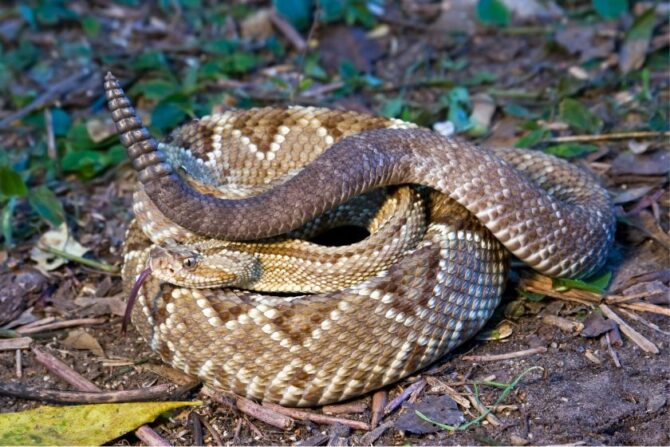
- Scientific name: Crotalus durisus
- Classification: Reptile
- Habitat: Forests, shrubs
- Diet: Carnivore
- Conservation status: Least Concern
This reptile is a highly venomous snake and a specie of the pit viper family.
There are seven recognized sub-specie of this snake, and they can be found on American continents.
The color of the snake differs from snake to snake. The pattern differs too.
These snakes thrive in Belize and are very dangerous because their toxic venom causes cellular necrosis.
Also, respiratory failure, blurred vision, difficulty breathing, and other severe symptoms could occur.
These snakes are known not to have any fear of humans. Avoid meddling with this snake if you encounter one.
Belize Wildlife Safety Tips
When exploring Belize or relating to the wildlife, some safety rules and regulations should be strictly adhered to ensure your safety.
Ensure you follow these do’s and don’ts. They include:
- Do not swim without a guard in Belize: The waters of Belize support a healthy population of dangerous animals which could fatally harm you. An experienced guard who can vouch for your safety should go with you when you plan to swim.
- Bugs can cause inconvenience; mosquitoes can cause malaria: Therefore, always wear light clothing that covers your entire body to protect you from leeches, mosquitoes, ticks, etc. Wear hats too, and do not forget to carry your insect repellent with you
- Be conscious of your steps: Stepping on snakes or other reptiles which could be resting is a recipe for disaster; tap the ground with your walking stick to alert them; the noise will make them retreat.
- Snakes hate being cornered: if you encounter one, let it be, do not block its route as it could get aggressive and bite.
- If you feel suspicious tingling, seek help immediately: A snake may have bitten you. Some bites do not register pain initially but could be fatal later on. Do not presume you are fine; only a doctor can certify you’re okay.
- Avoiding close encounters can keep you safe: Always keep a safe distance from these animals. Some of these animals don’t like when humans trespass into their territory. Getting too close could put you into trouble. Observe from a distance.
Frequently Asked Questions
Are there Anacondas in Belize?
Anacondas are supposed to be non-existent in Belize, but recently there was a sighting of a 33 ft-long Anaconda in the Cave Branch River in Belize.
Are there Alligators in Belize?
No, there are no alligators in Belize but rather Crocodiles. Although Belizeans often refer to these “Crocs” as Alligators, they are Crocodiles. China and America are the two countries known to be a habitat for Alligators.
Conclusion
Exploring the wildlife in Belize is nice, but failure to understand and respect the nature of these animals can be catastrophic.
They are lovely, and their presence help to create a balance in nature, but they can easily become violent if disturbed.
As much as possible, try and keep your distance from these most dangerous animals in Belize.
